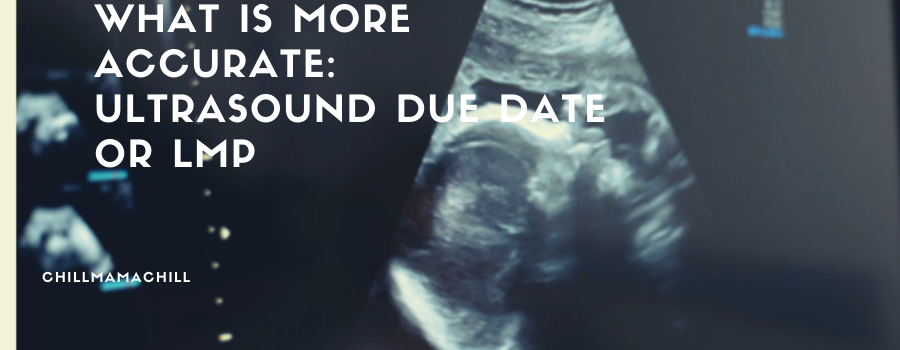Although very few women give birth on the actual expected due date, precise dating of pregnancy is important to improve outcomes. But when it comes to determining what is more accurate ultrasound due date or LMP, things get a bit murky.
There are several methods used to date how far gone a pregnancy is and ultimately when to expect your baby. Ultrasound due dates are more precise compared to LMP dating. This is because the method assesses intrauterine changes to give an accurate prediction.
If you’re pregnant, it’s important you know the expected delivery date of your bundle of joy. This enables you to prepare adequately for the arrival of your bundle of joy. But before we delve deeper, what is LMP and ultrasound due date? And what role do they play in determining the onset of spontaneous labor?
What is LMP Dating?
Long before groundbreaking technology that aids in prenatal care emerged, there was LMP. It stands for Last Menstrual Period and is a traditional way of determining the gestational age and the EDD (Estimated Due Date).

LMP has certain limitations when it comes to determining the anticipated due date. This is because of the apparent difference among women in the timing of ovulation, inaccurate recall of the LMP, or variability in length of an individual woman’s menstrual cycle.
The calculation assumes that the delivery date comes 40 weeks (280 days) after conception. Your due date is counted forward from the first day of your LMP. It is calculated using two techniques: The pregnancy wheel and Naegele’s rule.
The Pregnancy Wheel
Also known as a gestational calendar, this method uses your last menstrual period (LMP) to help determine how far along you are, and thus, your due date. You begin counting from the first day of your last period. Lining that date with the indicator on the wheel shows your EDD. However, the accuracy largely depends on the woman knowing the exact first date of her last menstrual period and if her menstrual cycles are regular.
The pregnancy wheel is the most prevalent technique used in most hospitals and clinics. It is easy to use and widely available. You can even purchase one online or install a pregnancy wheel app on your smartphone.
Naegele’s Rule
Named after the German obstetrician who invented it, Naegele’s Rule assumes a woman has a regular 28-day menstrual cycle. It is applicable when you can’t remember your LMP and have an irregular cycle. The possible delivery date is determined by a 3-step model that has proved effective.
- First, figure out when your previous menstrual period began.
- Next, go back three months in time from that day.
- Finally, subtract one year and seven days from the date.
For instance, if the LMP is stated as April 01, 2021, going back three months gives you January 01, 2021. Adding a year and seven days derives an EDD of January 08, 2022.
How Ultrasound Due Date Works
Ultrasound scans are the best option when a woman can’t quite remember her last menstrual cycle or has had irregular menses before pregnancy.
Ultrasound measurements of the baby are most precise in the first weeks of gestation, but they become less accurate as the pregnancy progresses. The optimal period for ultrasonography to determine gestational age is between the 8th and 18th weeks of pregnancy.
The baby can be measured as early as 5 or 6 weeks following the mother’s last menstrual period if the LMP is known. The starting day of the woman’s last menstrual period is matched with ultrasound exam measurements of femur length (FL), biparietal diameter (BPD), and crown-rump length to produce an accurate prognosis.
So, What is More Accurate: Ultrasound Due Date or LMP?
A 2021 study ran an assessment to ascertain the efficacy of LMP versus ultrasound to predict the delivery date. They observed that subjects whose delivery date was determined via ultrasound were more spot-on than candidates whose EDD was based on LMP. Therefore, it is correct to say that the ultrasound due date is more accurate.

Anecdotal evidence from tons of new mothers also supports this claim. My six-year-old and one-year-old were born on the same day, as stated on their respective ultrasounds. Unless you conceived via IVF (In-Vitro Fertilization), ultrasonography reading is the best way to calculate your baby’s arrival.
Suppose your EDD was first dated based on the first day of your last period, and upon getting an ultrasound, you are presented with a different date. So, what is more accurate: ultrasound due date or LMP? Well, go with the ultrasound due date.
But why the discrepancy? Since it is the same pregnancy, shouldn’t both methods yield similar results? It turns out there’s a perfectly good explanation for this occurrence.
Why Your Due Date May Change
At your first prenatal clinic, the obstetrician will determine an EDD based on the information you provide. However, it’s not uncommon for the doctor to quote a different due date during subsequent appointments. It may even change more than once. Should this be a cause of concern? This might happen if:
- You have irregular periods.
- The Doppler monitor indicated otherwise based on the fetal heartbeat. Typically, a Doppler will be used before the fetus is developed enough for an ultrasound.
- You had the ultrasound after the first trimester.
- AFP levels. AFP (Alpha-fetoprotein) is a protein that’s produced by the baby. When levels are elevated, you may get an inaccurate EDD.
When your anticipated delivery day is modified, your prenatal care isn’t affected (unless there’s an underlying medical issue that may harm the mother or fetus).
The Bottom Line
If you were wondering what is more accurate: ultrasound due date or LMP, science has given us the answers. Because ultrasounds consider fetal development and growth, it is undoubtedly more accurate than LMP dating. Regardless, the day your baby arrives will be beautiful, even if it isn’t the date predicted by your LMP and ultrasound.

I’m Cathrine and I’m a 39-year-old mother of 3 from Utica, New York. And I’m extremely happy you’ve come to visit my hide-out on the web. Here I post about everything related to family-life and usually it will involve babies and lessons I’ve learned over the years from experts, friends, and my own mistakes. So hopefully you will find what i write fun and informational!


